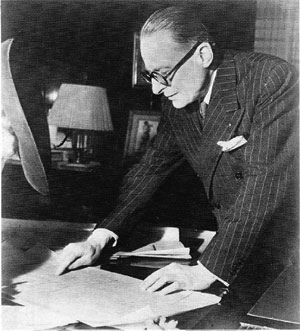Michel Roux-Spitz (1888-1957)
Born in Lyon in 1888, Michel Roux-Spitz died in Dinard in 1957. From 1908 he studied at the Ecole des Beaux-Arts de Lyon within Tony Garnier’s studio, before joining the Ecole des Beaux-Arts de Paris in 1912. He was awarded the Rome Prize in 1920. Influenced by Auguste Perret’s research on concrete, Roux-Spitz designed a series of buildings in Paris known as his ‘white series’ between 1925 and 1931. These buildings are made of reinforced concrete covered with white-stone facing and are embellished with bow windows. Roux-Spitz’s style was in keeping with rationalist Modernism, which at the time developed through emerging new construction techniques. However he did not forget the legacy of Classicism. This was when he invented his signature feature, three-part bow windows, which was soon copied by numerous architects.

View full biography
Michel Roux-Spitz was born in 1888 in Lyon and died in 1957 in Dinard.
He studies in Tony Garnier’s studio at the Ecole des Beaux-Arts of Lyon from 1908 and then joins the Ecole des Beaux-Arts de Paris in 1912. He wins the Rome Prize in 1920.
Influenced by Auguste Perret and his research on concrete, he designs between 1925 and 1931 a series of buildings in Paris nicknamed ‘white series’. These very buildings are made of reinforced concrete covered with white-stone facing et are embellished with bow windows. Roux-Spitz’s style is in keeping with rationalist modernism, which is at the time developped thanks to the emergance of new construction techniques, but he does not, for all that, forget the classical lessons. He invents at this time his signature, then copied by numerous architects: three-part bow windows.
Between 1925 and 1932, he is the editor-in-chief of the review called The Architect, belongs to the patronage committee of Today’s Architecture in 1930 and is editor-in-chief of French Architecture between 1943 and 1950. In these periodicals, he opposes to Le Corbusier’s new architecture principles but still defends modern architecture. He obtains during this time nu- merous important public procurements – urban designs for the city of Nantes (1945-1964) and the city hall of Saint-Nazaire (1959) – and conceives the famous Graystones Villa in Dinard, Brittany (1938-1950).
Greystones Villa, between the sky and the ocean, was de- signed by Roux-Spitz for his own use: he lives in there until his death in 1957. The house, covered with a terrace roof, is made of squarred rubble granite stones and is decorated with classic-style window frames made of reconstituted stone. Des- cribed by the architect as ‘a strong mass, a fortification’, its main façade shows a great patio door which gives access to a terrace which lies on a deocrated base while it is treated as an attique, according to the classical construction principles. On the other side, the great rotunda living room opens up to the ocean. The ensemble hinge upon three elements, according to the architect: the French-style formal garden with the Neptune fountain, the spiral staircase at the center of the house which gives access to the roof terrace and the fresco by Louis Bou- quet which represents the five-step imaginary voyage of a man dressed up in white. It now belongs to art collector François Pinault and has been classified a Historic Monument after the two-year restoration work.
Works
No Results Found
The page you requested could not be found. Try refining your search, or use the navigation above to locate the post.


